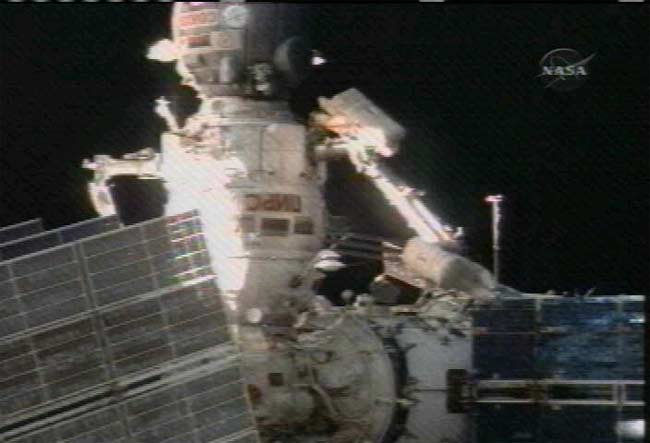Cosmonauts' Second Spacewalk Goes Smoothly

TwoRussian spacewalkers installed a docking target and changed out scienceexperiments during their second career spacewalk on Tuesday outside theInternational Space Station.
Thealmost six-hour spacewalk began on schedule at 1:08 p.m. EDT (1708 GMT)and allowed space station commander Sergei Volkov and flight engineer OlegKononenko to finish their tasks on time — despite an added, impromptu fix to adisabled ham radio antenna.
Thenormal maintenance duties stood in contrast to the first, riskier spacewalkthat took place on July 10, which required the cosmonauts to removean explosive bolt from the Russian Soyuz spacecraft docked to the spacestation. Both Volkov and Kononenko completedthat tricky task as first-time spacewalkers.
Today?ssecond spacewalk involved duties once slated for the July 10 extravehicularactivity, but pushed back due to the ongoing Russian investigation of amalfunction that caused the past two Soyuz spacecraft to subject their crews tobumpy ballisticreentries.
Thecosmonauts began the second spacewalk by installing a docking target on thezenith, or space-ward, side of the Russian Zvezda module. That will serve toguide in a new airlock, called the Mini-Research Module 2 (MRM2), which will bedelivered to the Russian part of the space station in 2009.
Thework required the spacewalkers to lift up flaps and insert an adapter intomounting holes that hold the docking target. Volkov wielded a camera to takepictures of the installation process, but both cosmonauts appeared eager to geton with the spacewalk.
?Ok,we?re not going to waste too much time on that, Oleg [Kononenko],? Volkov said,after taking several pictures.
Breaking space news, the latest updates on rocket launches, skywatching events and more!
Kononenkorode on the end of the 50-footStrela hand-powered crane to take additional photos of the space station,while Volkov maneuvered him using the crane.
Next,the two spacewalkers secured the Vsplesk or ?Burst?experiment, using clamps, wire ties, and support tethers. That physics experimentis designed to measure the effects of high energy particle streams near Earth.
Thecosmonauts took a breather to relax and gaze upon ?beautiful? thunderstorms onEarth, before finally receiving word that the ?Burst? experiment had startedfunctioning.
?Wehave telemetry,? said Russian mission control. ?Vsplesk is alive.?
Volkovwas directed to take time out of the schedule to fix a ham radio antenna thathad been disabled. The space station commander straightened out the ham antennaand fitted it back into its vertical slot.
?Pleaselet me go home,? Volkov joked. ?I guess we?ve done it all for today??
Heand Kononenko then turned to the final task of retrieving the Bioriskexperiment?s payload, which was installed by Expedition 15 crew members last summer. Thatexperiment studied the effects of space radiation and zero gravity on microorganisms.
Kononenkomoved to the experiment location and removed the Biorisk containers, whileVolkov retrieved a foot restraint from where it had been temporarily stowed.That same foot restraint had given Kononenko trouble on the first spacewalkwhen attached to the Strela hand-powered crane.
Thespacewalkers finally reentered the Pirs docking compartment and closed thehatch at 7:02 p.m. EDT (2302 GMT).
Mission controllers conveyed thanksfor the completion of the assigned tasks and the impromptu fix of the radioantenna, and remarked upon the July 10 spacewalk as well.
?Eventhe first attempt was perfect,? Russian mission control told the cosmonauts.?Everything was done professionally.?
- New Video: Dangerous Spacewalk: Handling Explosives
- New Video: Hurricane Bertha: View from a Million Feet
- New Video: Flame Trench Repair
Jeremy Hsu is science writer based in New York City whose work has appeared in Scientific American, Discovery Magazine, Backchannel, Wired.com and IEEE Spectrum, among others. He joined the Space.com and Live Science teams in 2010 as a Senior Writer and is currently the Editor-in-Chief of Indicate Media. Jeremy studied history and sociology of science at the University of Pennsylvania, and earned a master's degree in journalism from the NYU Science, Health and Environmental Reporting Program. You can find Jeremy's latest project on Twitter.
